


The WISE colors of Planet 9 have been estimated to be very different than the colors of brown dwarfs. This is why the point source in the Planet 9 simulation in the field guide looks blue.



The WISE colors of Planet 9 have been estimated to be very different than the colors of brown dwarfs. This is why the point source in the Planet 9 simulation in the field guide looks blue.
It’s only 23 days since launch. And you’ve already discovered stuff!
We are still working on interpreting your classification clicks, and we probably will be for many months to come. But people have already submitted more than 1100 interesting subjects using the Think-You’ve-Got-One form, which is a bit easier for us on the science team to use right away. Among these objects, science team member Adam Schneider quickly spotted at least three interesting ones that we’ll want to include in an upcoming paper. Let me tell you about them.
This one has got the science team all abuzz.

It’s either a fast dipole or a slow mover. It mover about 1.25 pixels between the first and last epochs. And it’s faint. Faint is good! That means it’s less likely to already have been discovered.
It’s a little red (maybe pink) in color, meaning it’s significantly brighter in the WISE 2 band than in the WISE 1 band. In fact, if you look at how bright it is in the WISE 1 and WISE 2 bands, and the fact that it doesn’t appear in the 2MASS catalog at all, you would infer that it is likely to be a kind of brown dwarf called a “T dwarf”. If it is a T dwarf, it is about 30 parsecs (98 light years) away. PLEASE FIND MORE OF THESE!!
We are trying right now to find someone who is at the right telescope at the right time to take a spectrum of it, which would confirm that it really is a T dwarf. A colleague offered to observe it for us this week using NASA’s Infrared Telescope Facility. Alas, the weather was bad, and they didn’t even open the observatory dome. There are some opportunities coming up for us to get a spectrum from other telescopes in Hawaii. We will keep you posted.
The next two new discoveries appear to be nearby M dwarfs, based on their WISE and 2MASS colors. Nearby M dwarfs like these should make good targets for future exoplanet searches with the Transiting Exoplanet Survey Satellite (TESS) and near infrared spectrographs like SPIREou, iLocator, and the Habitable Zone Planet Finder.
Take a peek at this subject. At R.A. 11.8858634 degrees, declination -34.5458256 degrees (halfway up, near the left edge) is a blue-white dipole that appears to be a previously undiscovered M dwarf. This flipbook is a bit tricky, since if you only looked at frame 1, for example, you might think it were covered with dipoles! But when you play the animation, it becomes clear that most of those sources are ordinary artifacts. Thanks to @raychieng for submitting it.
Finally, check out this subject. Near the top, slightly left of center, at R.A. 217.8208564 degrees, declination 86.2991835 degrees (it’s almost at the north pole), is a moderately bright white dipole, which also appears to be a previously unreported M dwarf. A VizieR search turns up a high-proper motion source at those coordinates in the PPMXL catalog and the URAT1 catalog, but without a spectral type. However, the photometry (i.e. how bright the star is, in magnitudes) across the suggests that this star is probably an M dwarf. Thanks to @stevnbak for submitting it.
How can you tell the spectral type of an object from its photometry? How can you recognize if your dipole/mover is an earth shattering new Y dwarf, a dazzling new T dwarf, a cool new M dwarf, or just a boring old early-type star? Stay tuned–we’ll talk about that in the next blog post.
Great work, everybody! These discoveries are the proof of concept that we were hoping for. And I’m sure there will be more to come.
If you’ve found something interesting in a flipbook and you want to know more about it, SIMBAD is the right place to start. Just figure out the object’s coordinates using the numbers on the left and bottom of the images, type them in to SIMBAD’s coordinate query page. And poof, you’ll have all the answers! Right?
Well it’s not always that simple. So let’s talk for a bit about what SIMBAD can tell you–and what it can’t tell you–about your favorite patch of sky. I’m going to try to explain here, from start to finish, how to use SIMBAD to reliably determine if if you have rediscovered a well known object with high proper motion, or if you have possibly found a new high-proper motion object, worth submitting on the Think-You’ve -Got-One form.
First of all, SIMBAD is an acronym. It stands for Set of Identifications, Measurements, and Bibliography for Astronomical Data. SIMBAD began in 1972 as database of stars only (no galaxies, asteroids,planetary nebulae, clusters, novae, supernovae, etc.). But other objects have since been added in. SIMBAD now contains about 4.5 million stars and 3.5 million nonstellar objects.
Note that SIMBAD’s inventory is still heavily biased towards stars. Astronomers have cataloged far more galaxies than stars, for example, and a small fraction of these appear in SIMBAD. The NASA/IPAC Extragalactic Database (NED), for example, contains more than 214 million distinct sources. The VizieR database contains even more. But those extragalactic objects are not the high-proper-motion object we are seeking. And VizieR is much less user friendly than SIMBAD. So you’re better off sticking with SIMBAD to start.
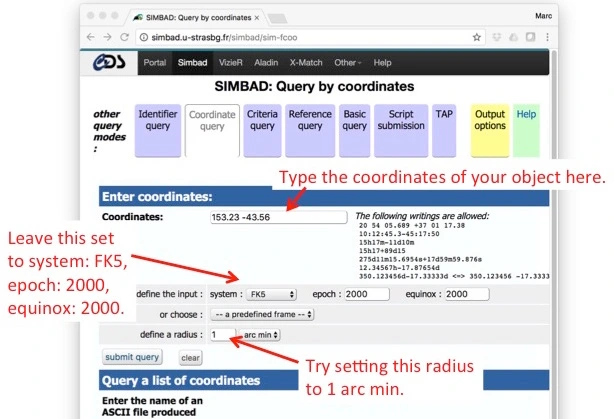
When you do a SIMBAD search, start by typing in the coordindates of your object. No comma needed. SIMBAD offers you chance to select a coordinate system; go with the default, which is FK5. Leave the epoch and the equinox (i.e. for the coordinate system) both set to the year 2000. But where it says “define a radius”, change that number to 1 arc min. Objects further than one arcminute from your search location are probably too far away to be the object you are looking for.
After you hit return or click, “Submit Query,” SIMBAD will take you to one of three places: a page saying “No astronomical object found”, a table of objects it found, or a page that’s all about one specific object. Here’s what the “No astronomical object found” page looks like. If you end up here, be sure to flag your object with the #notinsimbad tag in TALK and submit your object using the Think-You’ve-Got-One form! If not, it’s still possible that your object is not in SIMBAD, and hence an interesting find. So read on!

If SIMBAD finds more than one object within the radius you chose, it will take you to a table listing all the objects, in order of how far away they are in angular separation from the coordinates you typed in. Here’s an example table.
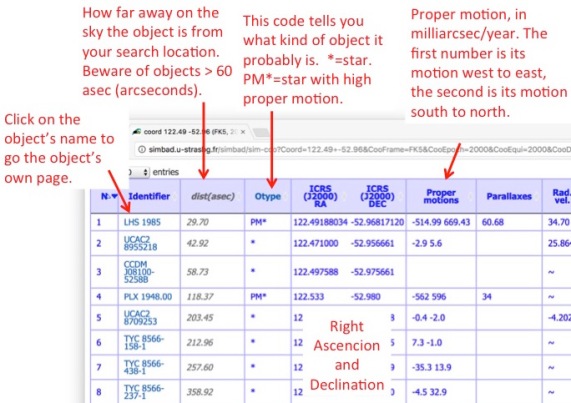
The first place to look on the table is the column that says dist(asec). That’s because your fist task is to make sure the object SIMBAD is showing you corresponds to the object you care about! If the distance in this column is more than about 60 asec (arcseconds), i.e. one arcminute, from the coordinates you entered, it may be too far away on the sky to match the object you care about, unless you were sloppy when you looked up its coordinates. Note that the spacing between the tick marks on the left of the flipbooks is about 3 arcminutes (180 arcseconds). I bet you were much more accurate than that with your measurement.
Next, since Backyard Worlds: Planet 9 is all about finding objects with high proper motions, you’ll probably want to check the Otype column and the Proper motions column. The Otype column lists some codes that indicate what kind of object the object is, according to SIMBAD.
“PM*” means star with high proper motion. If you spot an object with this label, there’s a good chance you’re seeing it as a dipole or mover. But note that objects with high proper motion are also sometimes labeled “BD*”, “WD*”, “Fl*”, “LM*”, “SB*”, or even “*i*” or “Q?”! Here is a guide to all of SIMBAD’s object type codes, and here are a few more, defined.
* = star
BD* = brown dwarf
WD* = white dwarf
Fl* = flare star
LM* = low mass star (i.e. less mass than the Sun)
*i* = star in double system
Keep in mind that one star can sometimes have many known properties that would demand multiple classifications in SIMBAD’s system. For example, you could have a low mass star that is also a flare stare and is in a spectroscopic binary system with a white dwarf. That object should probably be labeled something like “LM*, Fl*,SB*, WD*”. But SIMBAD only gives it one of those labels. Bummer. So check that column for objects called “PM*”. But just because you don’t see “PM*” on the table you get, doesn’t mean SIMBAD hasn’t located the dipole or mover you’re looking at. It might just have given it a different Otype label.
As a next step, you’ll want to look at the column labeled “Proper Motion”. This column is really sort of two columns smushed into one; it lists a pair of numbers. The first number is its motion west to east due to its proper motion. The second number is its motion from south to north) due to its proper motion. That first number is motion in the direction of increasing Right Ascension, so it’s sometimes called the Right Ascension component. The second number is motion in the direction of increasing declination, so it’s sometimes called the declination component. Just note that there are some additional weird subtleties about actually figuring out how the Right Ascension of a star actually varies in time because of the nature of the equatorial coordinate system.
Proper motion, as you may recall, is how an object moves on the sky as a result of having a different orbit around the Galactic center than the Sun does. Objects near the Sun (Planet nine is an extreme example) can also shift around on the sky due to parallax, i.e. the effect of the Earth’s orbit. Parallactic motion alone would make a star move round and round in an ellipse. Proper motion goes in a straight line. Together, parallactic motion and proper motion combine to make stars move in a squiggly path like this (below). Experts in astrometry (the craft of measuring stellar positions) look at plots like this one and disentangle the two kinds of motion from it.

Now, what really matters to us is figuring out if the object might be a dipole or mover that we could spot. And that depends on a different number than what’s listed in SIMBAD: the total proper motion. To get the total proper motion, you need to add together the two proper motion numbers you read in SIMBAD in a kind of funny way: you square them both, sum the squares and take the square root. Anyway, if a object’s total proper motion is bigger than about 100 milliarcseconds per year, it will probably show up as a dipole. If it’s bigger than about 1000 milliarcseconds per year, it will probably show up as a mover. If you don’t see any objects with total proper motion greater than 100 milliarcseconds per year on this table, flag your object as #notinsimbad and submit your object on the Think-You’ve -Got-One form!
A third possibility is that SIMBAD will find only one single object within the search radius you entered. In that case, SIMBAD will jump right to a page on that specific object, like the one below for the star Vega (its proper motion and parallactic motion are shown above). You’ll notice that this page also lists the object’s proper motion, if it is known. I’ve circled it in red on the screen shot below. The units here are milliarcseconds per year again, which is what we want.
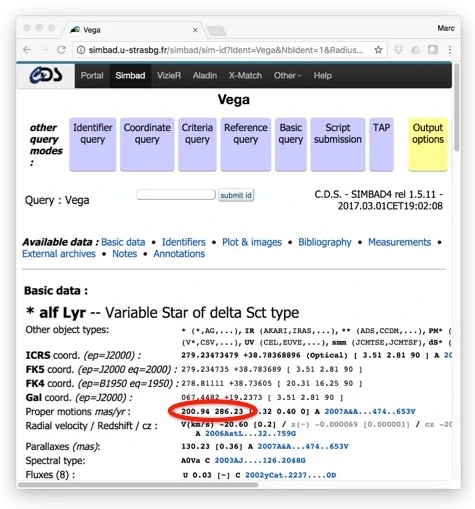
Let’s pretend your SIMBAD search pulled up this page. I’m super lazy so I’m just going to do it using Google as a calculator. Type sqrt(200.94^2 +286.23^2) into a Google search bar and you get 349.720597763. That’s clearly higher than 100 but less than 1000. So this star should show up as a dipole. Too bad. It’s already a well known high-proper-motion object. You can flag it with the #known tag on talk. But don’t submit it to the Think-You’ve-Got-One form.
Of course, sometimes, SIMBAD only finds one object, and it takes you directly that object’s page, and the object is clearly not the one you’re seeing in the flipbook! What if SIMBAD sends you directly to a page like the one below, for an active galaxy called M 81? There’s no proper motion listed because object outside the Milky Way don’t have proper motions.

If this happens, it means SIMBAD couldn’t find any high-proper-motion objects near the one you found. So go ahead and flag your object as #notinsimbad and submit your object on the Think-You’ve -Got-One form.
To summarize: SIMBAD can send you to one of three different pages. But–no matter where it sends you–if you can’t find an object on that page with TOTAL proper motion > 100 milliarcseconds per year, then you have an object worth flagging with #notinsimbad and submitting on the Think-You’ve-Got-One form.
One last comment. Good scientists take lots of notes. So I strongly encourage you to write notes in a subject’s TALK page about what you learned from SIMBAD. If you did find a high-proper-motion object in SIMBAD within a 1 arcsec search radius, type in some information about it, like its name, proper motion, otype, and distance to the coordiantes you used. That way people can check your work, and maybe they won’t need to repeat your search. We can also use your notes to develop a better understanding for our ability to recover known objects at Backyard Worlds: Planet 9. That’s an important way to measure the power of our search.
OK I think that’s enough for now. There’s lots more you can learn from SIMBAD of course. But maybe we’ll come back to that another day.
See you on TALK!
Best,
Marc
You probably didn’t realize it, but when you started classifying on BackyardWorlds.org you were actually helping us search the nearby solar neighborhood for cold hidden worlds called brown dwarfs. You might be asking yourself “Brown what”? And I’m here to answer that! Lets start from the beginning. Here is a cartoon version of star formation (on the left) and brown dwarf formation (on the right). They form the same way! The ingredients are a cloud of Hydrogen and Helium that collapses, fragments and then ignites. Now the difference is that the star can ignite nuclear fusion. The brown dwarf isn’t massive enough to get the core hot enough for that to happen. So instead of having a nuclear engine that sustains its brightness for millions or billions of years like stars do, brown dwarfs just cool off for their entire lives. 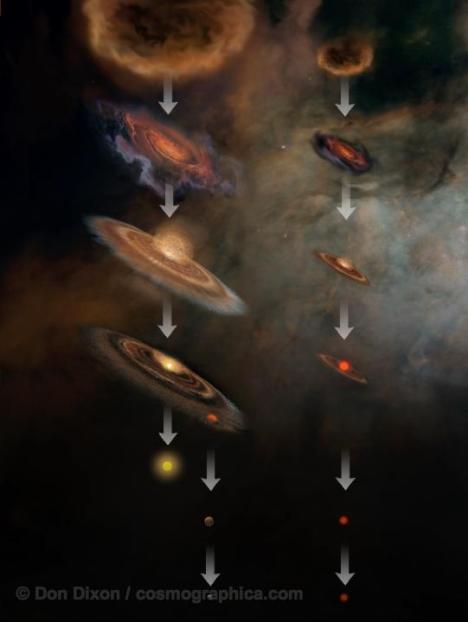
Want to know another kind of object that cools for the entirety of its existence? A planet. So I like to say that brown dwarfs are objects that form like stars but evolve like planets.
Now brown dwarfs have temperatures so low that the majority of their light doesn’t come out in visible light. While we now know that they are ABUNDANT in the Milky Way Galaxy, if you look up in the nighttime sky not a single one of those several thousand points of light you see is a brown dwarf. They are invisible to human perception. In order to find them we must turn to longer wavelength light. Brown dwarfs glow in the infrared. Thats why the NASA data we are using from the Wide-Field Infrared Survey Explorer (or WISE for short) is so critical to brown dwarf science. WISE has scanned the entire sky in the infrared and given us an unprecedented search tool for cold brown dwarfs near the Sun. In fact the WISE telescope was designed in part to be able to find the coldest types of these objects.
Brown dwarfs come in three types of “flavors”. There are L types, T types and Y types. See the image below for some details on the temperatures of these types.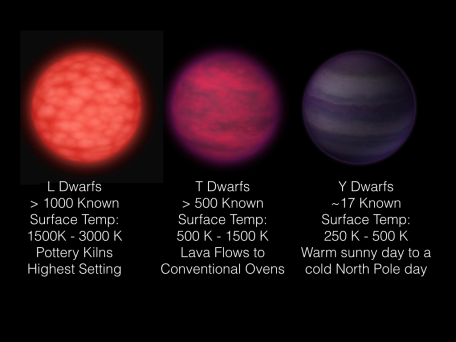 The L types are the warmest and the Y types are the coldest. Arguments could be made for which kind of brown dwarf is the most exciting to study but for the sake of this blog post I’ll tell you about two different ones that were stupendous discoveries to come out of mining WISE data the same way that you are doing.
The L types are the warmest and the Y types are the coldest. Arguments could be made for which kind of brown dwarf is the most exciting to study but for the sake of this blog post I’ll tell you about two different ones that were stupendous discoveries to come out of mining WISE data the same way that you are doing.
Just a few years ago an Astronomer from Penn State named Kevin Luhman was looking through the WISE data for objects that moved over the full timeline of the spacecraft. In 2013 he discovered a fantastic brown dwarf binary (named Luhman16AB after him) that turned out to be the 3rd closest system to the Sun. Until that time Astronomers figured they had the solar neighborhood solidified. The last time the top 5 closest objects to the Sun had changed was almost a century prior. More than that, Luhman16AB is a dynamic system. One of the objects is an L type and one is a T type. The L type appears to have large violent storms raging in the outer atmosphere. Astronomers have made maps of it and are using it to understand what exoplanet weather might look like. This binary had been missed by numerous professional and very experienced astronomers (myself included) because it moves very fast and is in a particularly crowded part of the sky. By blinking images you might be able to uncover another bright, beautiful system like this one.
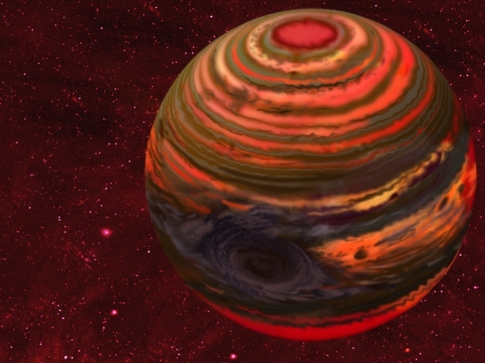
The second object I want to tell you about is one of the most exciting discoveries I’ve seen in my career as a brown dwarf scientist. Its an object called WISE0855 and its a Y type brown dwarf with a mass between 3 – 10 times that of Jupiter and a surface temperature equivalent to a balmy day at the North Pole. Dr. Luhman also found this one by blinking images and it turns out to be the coldest compact source ever discovered outside our own solar system. It’s so cold that its outer atmosphere is likely teeming with water ice clouds. In 2014 I wrote a paper on the indications of those water clouds in the object and in 2016 I worked with a team that obtained the very first spectrum of it. We directly compared it to Jupiter and found striking similarities. Best of all, WISE0855 is the 4th closest system to the Sun. Just a bit further than Luhman16AB. In just one year, WISE data completely changed the solar neighborhood. This should make you wonder, what else is out there? With so many eyes working on the WISE dataset I’m hoping we pinpoint a brown dwarf that is closer than proxima centauri (the closest star). One that is covered in strange exotic clouds. Hopefully one of our thousands of volunteers is blinking an image right now and marking a key object in understanding the atmospheres of worlds beyond our solar system.
Good Luck Searching! — Jackie
Since Mike Brown and Konstantin Batygin announced evidence for the existence of a distant ninth planet in the solar system, astronomers have been furiously analyzing and collecting data in hopes of being the first to spot it. A lot of the excitement is driven by the fact that planet nine may already have been detected in existing data sets. Astronomers love the idea of sifting through a huge pile of data to make that one epic discovery, and planet nine is the ultimate “needle in a haystack” adventure.
The standard approach to detecting a faint Trans-Neptunian Object (TNO) such as planet nine is to look for its reflected sunlight using the biggest ground-based visible light telescopes on Earth. There are several planet nine searches of this type currently underway. Mike Brown is using the Subaru 8 meter telescope on the Mauna Kea mountain top in Hawaii. Scott Sheppard is leading a dedicated TNO survey using the Dark Energy Camera (DECam) instrument on the Blanco 4 meter telescope at Cerro Tololo, in Chile. David Gerdes is also using archival DECam data to hunt for planet nine, and recently discovered “DeeDee” a possible dwarf planet over ninety times more distant from the Sun than the Earth. However, none of these surveys has yet or ever will cover the entire sky.

Since April 2016, I have been performing an automated planet nine search using WISE data, with help from my colleagues Benjamin Bromley, Peter Nugent, David Schlegel, Scott Kenyon, Edward Schlafly, and Kyle Dawson. WISE is a bit of an “X factor” when it comes to the search for planet nine, because using it to look for TNOs is very unconventional. WISE is comparatively a tiny telescope (0.4 meter diameter), and observes in the infrared from low-Earth orbit (as opposed to visible light from the ground). With WISE, we are searching for intrinsic emission from planet nine itself, rather than reflected sunlight. The big advantage of WISE is that it has already covered the entire sky more than six times. However, the main disadvantage is that there is an enormous uncertainty in how bright or faint planet nine might appear in the infrared. So planet nine might very well exist, even if it turns out that WISE can’t detect it.

My automated planet nine searches will likely have major problems in certain areas of the sky, particularly in the plane of our Milky Way galaxy, where there are huge numbers of background stars. This is where we really need Backyard Worlds: Planet 9. In the search for rare moving objects, professional astronomers often painstakingly blink through thousands or even millions of images by eye. Having a team of citizen scientists look through the WISE images will help make sure that no brown dwarf or ninth planet in this data set evades discovery.
Backyard Worlds: Planet 9 is my first time being involved in a citizen science project, and it’s been a lot of fun so far, even though I know we’re just getting started. Thanks for joining the search!
Aaron Meisner
This post was updated on 1/20/19 to go with the reboot images.
There! In frame one: a red dot. And there it is in frame two, halfway across the image!
Fast movers. They are tantalizing. A nearby star or brown dwarf can only crawl so far in the four year time span of our data. The star that currently holds the record for the highest proper motion is Barnard’s Star, which plods along at a leisurely 10.36 arcseconds per year (3.8 pixels per year). If you see an object that moves more than about 0.01 degrees (16 pixels) between the first and last frames, it may be moving too fast to be a star or brown dwarf; you’d have to consider the possibility that it might be in our own solar system.
But are those flying red dots Planet Nine?? Well, it’s not that simple.
Let’s start by take a closer look at how planets move on the sky. Here’s a spectacular multi-exposure image of the planet Mars from Astronomy Picture of the Day. As you can see, Mars takes a complicated, looping path through the sky. So do all planets in the solar system. As you may know, that’s why they are called “planets”; the word stems from a Greek word meaning “wanderer”.
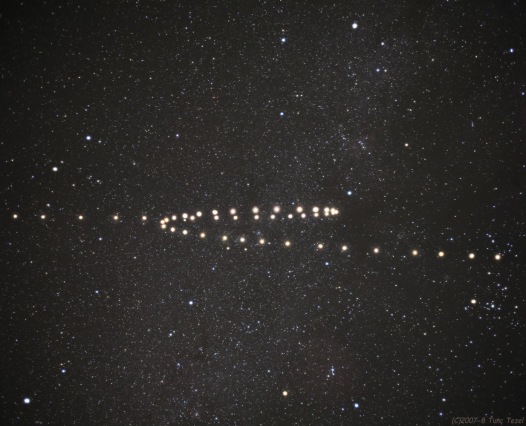
Planets in the solar system move in these loops because their motion on the sky is the sum of two components: the planet’s orbital motion around the Sun, and the motion of the Earth around the sun, which changes our point of view. The component of the planet’s motion that is caused by the Earth’s orbiting around the sun is called “parallactic” motion.
So what does this mean for us here at Backyard Worlds: Planet 9? We can’t see the planet’s whole looping path because we have only four exposures. But we still know a fair bit about what the motion will look like. It will be the sum of two components: the planet’s slow orbital motion and the relatively speedy parallactic motion. We know that the parallactic motion will be the faster, dominant component, simply because the Earth is much closer to the Sun than Planet Nine is, so it orbits faster. And we know what the Earth’s orbit is, so we know a lot about that dominant parallactic component of the motion.
Here is a simulation, from the field guide, of how Planet Nine might appear in a Backyard Worlds flipbook. First of all, notice that Planet Nine’s motion is more or less right to left (West-East) because it’s roughly in the plane of the solar system. If you see a fast mover moving vertically in the flipbook, be very suspicious. We can not really see asteroids or comets in our images. So a fast vertical mover is probably just noise.
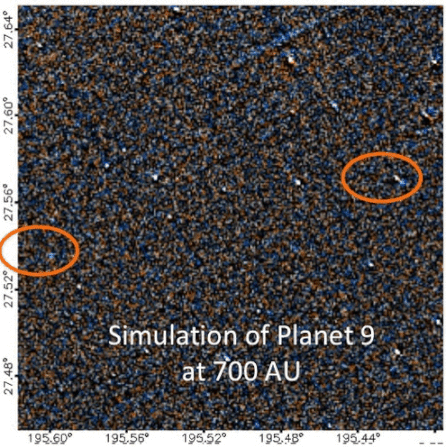
Second of all, notice that there are two copies of planet nine! The second copy is created by the motion of the Earth around the sun: the “parallactic” motion. If the planet is closer than 700 AU, the parallactic motion will be bigger, and the two images will be farther apart. They might not even fit in one image. The size of the images we show is a compromise; if we made them too big they might be better suited for finding some nearby versions of Planet Nine, but then they would each take forever to scan. For that reason, we’ve provided links in the metadata (click the “i” button under the flipbook to see the metadata) that allow you to visit adjacent (pre-reboot) images to trace your favorite mover from one subframe to the next.

So what are those bright spots you’re seeing flying across that flipbook? Some of them are random noise, caused by the non-zero temperature of the detectors (you might call that “heat”). Some of them are probably caused by cosmic rays, those vagrant high energy protons and atomic nuclei that traipse in from beyond the solar system, sometimes bearing fascinating news of distant explosions, sometimes just being nuisances. If the images you are looking at are from a declination of roughly -25 degrees, the cosmic rays can be especially pesky. At this declination, a droopy bit of the Earth’s magnetic field called the South Atlantic Anomaly allows cosmic rays to get a little bit closer to the WISE satellite than we might prefer. Here are some examples of what cosmic ray hits do to WISE images. Cosmic ray hits are another reason why we need human eyes to examine these images.
Hey, nobody said finding Planet Nine would be easy. But, hey, in the reboot images, we’ve been able to made those cosmic rays much fainter, and Planet Nine easier to recognize. Thanks to @RonArzi for requesting this post, and thanks to you for reading it!
Best,
Marc
So you’ve been playing with Backyard Worlds: Planet 9 for a day or two now, and finding some interesting critters. You read the F.A.Q. and learned how to read an object’s R.A. and declination using the numbers on the bottom and left edge of the images. You’ve even looked up some of your favorite objects in SIMBAD using those coordinates. And most of them are listed in SIMBAD, maybe as high proper motion stars. But some of them are #notinsimbad!!
If you’re starting to find objects that are not in SIMBAD, it’s time to take a peek a VizieR. VizieR is harder to use than SIMBAD, but it also has many many more sources in it. So if you find something that’s #notinvizier, well that’s a big deal. And even if the object you found is in VizieR, it’s entirely possible that nobody realized that it’s a moving object! That’s also a big deal.
So how do you use VizieR? First, you’ll want to type in your object’s coordinates. but don’t type them into the search bar on the top of the page. Type them into the search bar that is labeled “Search by Position across 16780 tables” (the number of tables might be different when you get there).

Next click “Go”. (You can’t just hit return.)
Now you should see a huge page full of tables like the one below. Each one contains the results from searching a different catalog. Every year, VizieR adds more tables to its repository, so every year the pages get longer and longer.
This one below lists sources from the USNO-A2.0 Catalog. USNO is the U.S. Naval Observatory. They have a long history of carefully and accurately measuring the positions of stars. Can you guess why the Naval Observatory got interested in positions of stars?

Anyway, turn your attention now to the column labeled “r” on the left of the table. Every table has one. This column shows the angular distance between the source in the table and the coordinates you entered. That’s important! The sources are listed in order by distance. So when you look through the tables, start by looking at the source in the first row; it’s the closest one to where you thought your source was located. Then work your way down. It’s easy to make a mistake of 1 arcminute (roughly 0.017 degrees) when you are are reading the coordinates of your favorite object off of the flipbook axes. But the tickmarks on the flipbooks are about 2.4 arcminutes apart; you probably didn’t get the coordinates wrong by that much.
Now, since Backyard Worlds: Planet 9 is all about finding moving objects, the next thing you might want to do is search the page for known moving objects! There are two phenomena that make objects in our project move across the sky: proper motion and parallax. Parallax is caused by the Earth’s orbital motion, which changes our point of view. Proper motion is caused by the object’s own motion through space. Proper motion is generally easier to measure; many more objects have measured proper motion than measured parallax.
Proper motions are measured in milliarcseconds per year (mas/yr). A milliarcsecond is 1/1296000000 of a circle, i.e. a very very small angle. A typical pizza in a New York pizzeria is about one milliarcsecond across…if you are looking at it while standing in California.
Now on to the business of deciding whether you have made a big discovery. Let’s search the VizieR page for measurements of proper motion. On my Mac, I can search within a webpage using the COMMAND F buttons on my keyboard. There is probably a similar keystroke on a PC. There are two directions of proper motion: proper motion in Right Ascension and proper motion in declination. The corresponding search terms to use are “pmra” and “pmdec”. Go ahead and pick one of those search terms and do a search, and see what you get.
If someone else has already found your dipole/mover there will be a source somewhere on the page with a proper motion–ra or dec–that’s greater than about 100 milliarcseconds per year (mas/yr). If you can’t find such an object in the whole page, then your object is #notinvizier.
On Backyard Worlds: Planet 9, objects that we see as movers tend to move at least 900 milliarcseconds per yer. Dipoles can range down to about 100 milliarcseconds per year if they are bright. So the idea here is to see if anyone else has previously published a dipole or mover near your search coordinates.
Here’s an example of a catalog on VizieR that lists proper motions. One of the measured proper motions is circled in red because it’s more than 100 milliarcseconds. That’s what you have to keep an eye out for. But note that this particular object, with pmRA=106.0 milliarcseconds per year, is r=1.6012 arcminutes away from the search coordinates. So that might be a different object after all…

Now, there are many catalogs of stellar proper motions. You may find they contain contradictory information! I want to call your attention to one called “Gaia DR 1”. That’s a catalog containing the first data release from ESA’s GAIA mission. It just came out this summer. It is very deep and very accurate–probably the most reliable proper motion catalog. If you find that a particular source located, say, r=0.394 arcseconds from your search coordinates appears in multiple astrometric catalogs, the Gaia DR1 measurements are the ones I would trust. If you can’t find the object in Gaia DR1, a decent rule of thumb is to go with the catalog with the most recent publication date.
Note: do not trust the proper motions from the AllWISE Catalog! They are not really proper motions! They are mislabeled in VizieR.
After you finish examining the data on proper motion, the next thing to do is to search the page for “type” to lean what other researchers think the object’s spectral type is. You may find nothing, or you may find that different catalogs have differing opinions. This article by Alan MacRobert provides a good introduction to spectral types and stellar classification. If you do not see a spectral type listed, we may want to follow it up to get a spectral type, even if someone else previously recognized the object’s high proper motion. If you do not spot a spectral type on VizieR, flag the object with the #nospectraltype flag on TALK.
Conflicting measurements are one potential pitfall with using VizieR. There are more potential pitfalls. For example, while you are using VizieR, that just because a table comes up where the name of the table mentions “quasar” for example, that doesn’t mean your object is a quasar. It may be a table from a paper that is mostly about quasars–but this particular table is a list of the rejects, or the calibrators.
All this can get confusing, I know! VizieR is a powerful tool meant for professional astronomical research, and it is not very user-friendly. Don’t worry if it doesn’t make sense at first glance; congratulate yourself on making the effort to use it! Don’t be afraid to ignore this whole blog post and just focus on doing classifications or using SIMBAD. And don’t be afraid to ask us for help, e.g. on TALK.
And remember, if you find a mover or dipole that is not in VizieR, or which is in VizieR but has no spectral type, be sure to make a note of it in TALK using the #notinvizier or the #nospectraltype tags. And be sure to submit it using the Think You’ve Got One form.
Thanks to Lucero Lopez, Cara_na and Sehajroop Bath for requesting this article! Good luck to everyone!
Marc Kuchner
Hi! Welcome to the new Backyard Worlds: Planet 9 blog. My name is Marc Kuchner, and I’m excited to begin this search with you. I suppose you could call me the PI of this project, though I blame Dr. Jackie Faherty for coming up with the idea for it.
One day, I went to visit the Carnegie Institution Department of Terrestrial Magnetism, where Jackie used to work. I went there to give a talk about another citizen science project of mine called “Disk Detective”. Disk Detective.org is a super-fun ongoing Zooniverse project where we study images of stars using data from NASA’s WISE telescope. After I gave my talk, Jackie came up to me and said: hey, what about examining the moving objects in the WISE images? They could be brown dwarfs or even planet nine! We should launch a new citizen science project to look at those.

I had my hands full with Disk Detective and other projects, so I more or less ignored Jackie’s idea at first. But then one day I met Dr. Adam Schneider. Adam had been studying moving objects in the WISE images, and he needed help. He had looked at one million WISE images all by himself, hoping to find new nearby brown dwarfs. He had found many! But he was sure the best ones, the coldest, nearest ones, were still hiding in the data. Wouldn’t it be great if he had some friends with fresh eyes to dig deeper into the data with him? A citizen science project would be just the thing.

I still wasn’t quite sold on the idea. But then I met Dr. Aaron Meisner. Aaron had just reprocessed all the data from WISE in a new way, dividing it up into several epochs so you could easily see moving objects. He was beginning to scan through the new data set looking for evidence of planet nine. But even with the latest computers and algorithms, his search was bogged down in the galactic plane, where moving objects can easily get lost in crowded fields of stars. Aaron needed help with his search, too.
Jackie, Adam and Aaron and I put our heads together, and with lots of help and patience from Laura Trouille and the other folks at Zooniverse, we came up with this project: Backyard Worlds: Planet 9. Brown dwarf expert Joe Fillipazzo, another expert on brown dwarfs, and Shawn Domagal-Goldman, an expert on planetary atmospheres, joined the crew. Matt Beasley from Asteroid Zoo shared his wisdom. Lots of wonderful beta testers showed up. And here we are, after about twelve months of work, just about to launch. Wow.
But wait, there’s more! During the beta test, I learned that, in a way, this project had been dreamed up by citizen scientists even before invited them to participate in it. On January 24, 2016, a new topic appeared in the Zooniverse Project Building TALK forum, “planet 9, could someone with access to big telescope data set up a new project to search.” Users @TLSanders, @johnfairweather, @PolishPlanetPursuer, @JeanTate, @zutopian, @PlanetGazer8350, @planetaryscience, and @MvGulik began debating the evidence for a ninth planet, and tinkering with new projects to find it. I hope Backyard Worlds: Planet 9 lives up to their hopes.
If you helped with our beta test, thank you! We made many improvements to the site thanks to your feedback. The flipbooks now play automatically and continue to play (unless you stop them). The images now are labeled with celestial coordinates so you can easily look up the interesting sources you find in other astronomical catalogs. There are more examples of each different kind of object of interest (movers, dipoles, planet 9) in the field guide. I think the site really rocks. But if you think of more ideas on how to improve it, please drop us a line on TALK.
And thank you to everyone for giving this new project a try. We’ll post more articles and stories right here–you’ll be hearing from other members of the science team as time goes by–and we’ll be chatting with you on TALK. We’re looking forward to getting to know you, and we hope you make a really cool discovery!
(That’s a pun, by the way. Brown dwarfs and planet nine are cool because they have very low temperatures.)
Marc Kuchner